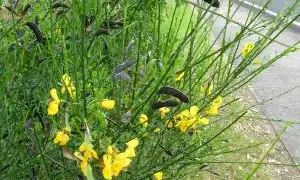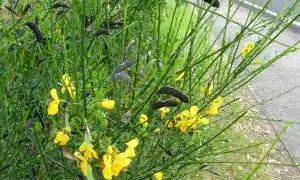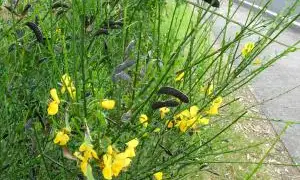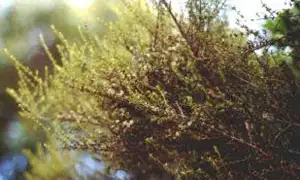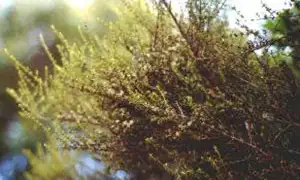Botanical name: Leptospermum scoparium
Family name: Myrtaceae
Overview
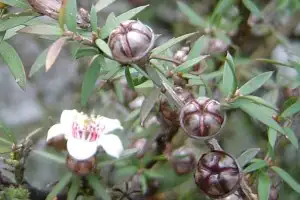
Manuka.
Manuka is a perennial scrub species native to New Zealand, and is probably our most troublesome native scrub species. It is generally not a good competitor as a seedling, often establishing after the ground has been cleared in hill country for pasture improvement. It can grow several metres tall once it has been established though, often forming dense thickets.
It is found throughout New Zealand, and is sometimes called "tea-tree”, a name given to it by Captain Cook who used the leaves to make tea. A weed is a plant growing where it is not wanted, interfering with human activities. Ironically although we have spent many decades trying to control manuka in our hill country pastures, now we are actively trying to grow manuka.
It has long been used as an ornamental shrub in amenity plantings, and several cultivars are available with different coloured flowers. The oils extracted from the crushed foliage of manuka contain an antibiotic agent called methylgloxal which is claimed to have many medicinal properties.
Likewise, the honey produced from manuka is also claimed to have many useful properties. As a result, farmers are now planting those manuka cultivars on hill-country land which have high concentrations of the antibiotic agent, sometimes killing other manuka plants first which only have low concentrations of the chemical.
At Massey University, we have been researching techniques to establish manuka both for this and as part of revegetation projects.
Distinguishing features
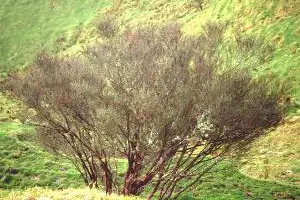
Manuka growing on the hill side.
Manuka has large numbers of very small leaves, up to 12 mm long and about 4 mm wide. These might be confused with another troublesome scrub weed, tauhinu, but the underneath of tauhinu leaves is almost white in colour, quite different to manuka. Tauhinu leaves have rounded tips whereas manuka leaves have quite pointed tips. Tauhinu has wind-blown pappus attached to its seeds.
Manuka capsules split to release many tiny seeds, which can blow around in the wind because of their small size, but don’t have pappus attached. Another weed very similar in appearance to manuka is kanuka (Kunzea ericoides). This is more closely related to manuka than tauhinu, being from the same family. The leaves are very similar in size and shape, though not quite as pointed as in manuka. The flowers tend to be a bit smaller than in manuka, in groups of two or three on branch tips. The fruits are a slightly different shape, being narrower.
I always think manuka fruits look like little hot-cross buns whereas the kanuka fruits look more like tiny wine goblets. Kanuka tends to grow taller than manuka when fully grown, being more of a small tree whereas manuka is much more a shrub species.
Another similar looking species is mingimingi (Leucopogon fasciculatus) which has similar leaves which are a bit larger than manuka, though the flowers look different and it produces berries.
Control
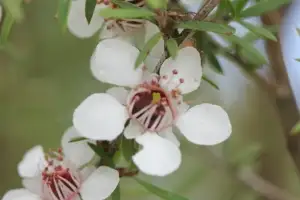
Flowers on the manuka.
Manuka is more susceptible to physical weed control strategies such as scrub-cutting than many other woody weeds in New Zealand. Weeds such as gorse usually regrow quickly from stumps after being cut just above ground level with chain saws or slashers, whereas such treatment is usually sufficient to kill manuka.
The hormone herbicides such as triclopyr and picloram appear to be fairly weak on manuka, so glyphosate, metsulfuron, or a mixture of these two, are used when chemical control is required.
Because of its susceptibility to competition as a seedling, keeping pastures competitive or establishing grass/legume ground covers in forests will help stop new manuka from establishing once old plants have been destroyed.
However, if you wish to grow manuka, we have found that simazine can be used as a residual herbicide to stop weeds germinating around planted manuka seedlings while it establishes, or haloxyfop can also be used to kill grasses that establish beside it and clopyralid will control many broad-leaved weeds safely.
Glyphosate can also be used to control weeds around establishing manuka plants if a shield is used to protect the manuka from the spray, such as using a cut-out half-bucket.
